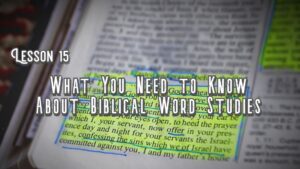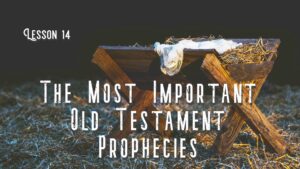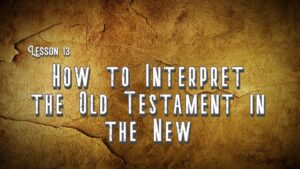Lesson 11 hopefully opened your eyes to the importance of Old Testament studies. Lesson 12 will show you exactly how this is foundational to understanding the New Testament.
Recall the estimated 855 references to the Old Testament scriptures within the New Testament. This means that some citation to the OT is found on almost every page of the NT. Sometimes an OT reference is loud and boisterous. At other times, the reference is a soft whisper. Don your spectacles and learn the difference between a yell and a whisper.
1. Quotation
This is the loudest and easiest type of reference to identify. When a Bible writer says anything along the lines of, “As it is written…” your sensory feelers should go off. This is a classic way of the Holy Spirit saying, “Listen up, I’m about to quote something you can go and read word for word in the Old Testament!” Most Bible editors will even be so nice as to italicize and indent these quotations in your Bible. (Examples: Matthew 1:23; Mark 12:36; Luke 19:38; John 12:14-15; Acts 2:34-35; Romans 15:21; 1 Cor. 2:9; and others)
2. Allusion
This type of reference is a little more difficult to spot. An allusion is when the author indirectly references the Old Testament in such a way that it does not disturb the flow of writing. There is no introductory formula such as, “That it might be fulfilled…” (Matt. 1:23). An allusion is much more subtle than this. Observe the following example from Matthew 24:30:
“Then the signs of the Son of Man will appear in heaven, and then all the tribes of the earth will mourn, and they will see the Son of Man coming on the clouds of heaven with power and great glory.”
This last phrase about the Son of Man coming on clouds is a direct allusion to Daniel 7:13. If you set the two texts side by side, there is no doubt in this parallel. Jesus might as well have used an introductory formula and quoted Daniel, but He didn’t. Daniel’s prophecy is woven into the text so that only people familiar with their Old Testament and Daniel will be able to identify the reference. (Examples: Matthew 2:20; John 1:11, 1:14, 1:29; 4:13-14; Peter 1:22-25)
3. Echo
This type of reference wins the award for most likely to fly under the radar. Echoes are like allusions but shorter. While an allusion may be a sentence in length, an echo can be as brief as a single word. Consider echoes that are common in the English language like “9/11” or “Katrina.” These single words or phrases illicit immediate flashbacks to monumental moments in American history without any further explanation. Here is a great example of an echo found within the story of Jesus’ transfiguration:
“And behold, two men talked with Him, who were Moses and Elijah, who appeared in glory and spoke of His decease which He was about to accomplish at Jerusalem.” (Luke 9:30-31)
The Greek word for “decease” is “εξοδον.” This Greek word literally means “exodus.” With one word the Holy Spirit provides context to Jesus’ transfiguration and death. The transfiguration occurred so the disciples could see the glory of Jesus that was to be veiled when He hung on the cross. They were supposed to understand from this event, that when Jesus died on the cross, He was leading the people of God in a salvation event like the Exodus but greater than the Exodus. Go to fiveminutebiblestudy.com and see The Bible Themes Series for more on this New Exodus theme. The point of using Luke 9:31 is to show just how subtle an echo can be. Echoes can be difficult to spot as said before, and they require an advanced handle on the Old Testament narratives, prophecies, and so forth. Even then, it can be difficult to identify a true echo. (Examples: Mark 1:11/Psalm 2:7, Matthew 16:18-19/Daniel 2:44-45, Romans 3:20/Psalm 143:2, Matt. 24:1/Ezekiel 0:18)
4. Midrash
This is a Hebrew name for a common feature found in Jewish literature, including the Bible. As Peter Rodgers defines the term, a midrash is, “running commentary on the scriptures,” (41). While this rigid definition may mean nothing to you, consider this more crude explanation. In Simple Simon terms, a midrash is when the writer takes two or more passages and combines them together. Together, the combined passages are used by the writer to help interpret whatever is under discussion. Consider this midrash:
“Behold, I send My messenger before Your face, who will prepare Your way before You. The voice of one crying in the wilderness: ‘Prepare the way of the Lord; make His paths straight.” (Mark 1:2-3)
Perhaps you have read this passage a hundred times and never knew that Mark is not quoting a singular passage from the Old Testament. On the contrary, Mark combines passages from Exodus 23:20, Malachi 3:1, and Isaiah 40:3, quoting variant phrases from each passage as if it were a single quotation. This is a classic midrash at the very beginning of the gospel. This does two things: it sheds meaningful light backward on the OT texts quoted, and it shines light forward on the ministry of Jesus. The bottom line of Mark 1:2-3 is that Jesus is the epicenter of biblical history. Three is better than one, as Solomon said, and all three of these OT prophecies combine to effectively prove the fulfillment found in the gospel of Jesus. (Examples: Mark 1:11, 14:62; John 10:7-29; Romans 3:10-18; Hebrews 10:37-38; 1 Peter 2:6-8)
Conclusion
You can be saved without ever having learned the term “midrash.” In fact, I suppose many people will be in heaven who never heard of an “echo.” Knowing these terms and how to discover them are not saving grace in themselves. However, many times the right doctrine is taught from the wrong text, or simply a false doctrine is taught because of ineptitude in understanding how the New Testament uses the Old. It takes practice to get good at identifying allusions, echoes, and midrash. Start practicing, and your Bible reading will take on new levels of purpose.
Homework Questions
1. True or False:
An echo is more subtle than an allusion, and an allusion is more subtle than a quotation.
2. Fill in the Blank:
“Daniel’s prophecy is woven into the text (Matt. 24:30) so that only people familiar with their ________ ____________________ and ______________ will be able to identify the reference.”
3. What is a midrash?
There is a midrash in Romans 3. Find the midrash and then write down all the different Old Testament scriptures found in it. (Hint: use a Bible that has a center column reference to make this exercise easier.)
Helpful Resources
Exploring the Old Testament in the New by Peter Rodgers
Handbook on the New Testament Use of the Old Testament by G. K. Beale



